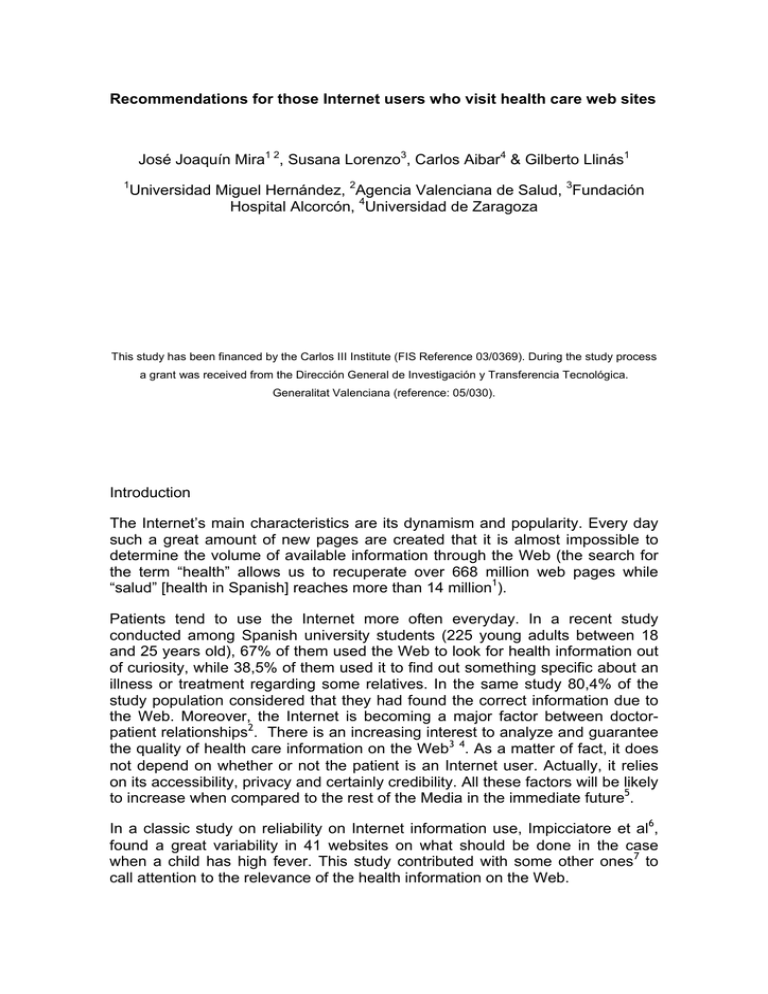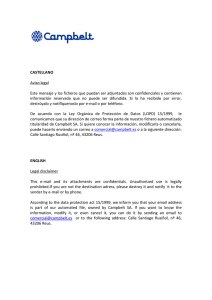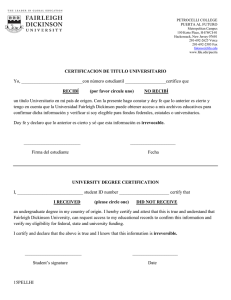Recommendations for those Internet users who visit health care web
Anuncio

Recommendations for those Internet users who visit health care web sites José Joaquín Mira1 2, Susana Lorenzo3, Carlos Aibar4 & Gilberto Llinás1 1 Universidad Miguel Hernández, 2Agencia Valenciana de Salud, 3Fundación Hospital Alcorcón, 4Universidad de Zaragoza This study has been financed by the Carlos III Institute (FIS Reference 03/0369). During the study process a grant was received from the Dirección General de Investigación y Transferencia Tecnológica. Generalitat Valenciana (reference: 05/030). Introduction The Internet’s main characteristics are its dynamism and popularity. Every day such a great amount of new pages are created that it is almost impossible to determine the volume of available information through the Web (the search for the term “health” allows us to recuperate over 668 million web pages while “salud” [health in Spanish] reaches more than 14 million1). Patients tend to use the Internet more often everyday. In a recent study conducted among Spanish university students (225 young adults between 18 and 25 years old), 67% of them used the Web to look for health information out of curiosity, while 38,5% of them used it to find out something specific about an illness or treatment regarding some relatives. In the same study 80,4% of the study population considered that they had found the correct information due to the Web. Moreover, the Internet is becoming a major factor between doctorpatient relationships2. There is an increasing interest to analyze and guarantee the quality of health care information on the Web3 4. As a matter of fact, it does not depend on whether or not the patient is an Internet user. Actually, it relies on its accessibility, privacy and certainly credibility. All these factors will be likely to increase when compared to the rest of the Media in the immediate future5. In a classic study on reliability on Internet information use, Impicciatore et al6, found a great variability in 41 websites on what should be done in the case when a child has high fever. This study contributed with some other ones7 to call attention to the relevance of the health information on the Web. Eysenbach & Köhler8 found out that the most credible health web sites were those with a more professional appearance, those using a more comprehensive language, and those that included references to the original sources. Our own data, in a study conducted in Spain, showed similar results9. Furthermore, data illustrates that Internet users give more credibility to those pages when they consider that they contain full information, when navigation is easy and quick (downloading time is less than 10 sec.), the web page is updated on a regular basis, when it appears between the first results in the Internet search main engines (Google, Yahoo, Lycos), and when the banners are easily differentiated from the contents’. One of the advantages of Internet that was identified10, was that it can contribute to increasing the patient’s compliance11 12 and, to help him/her to improve or maintain their health in best shape (e.g. pre-operatory counselling, less bureaucracy), to enroll in clinical trials13, and to identify relevant information to contrast with their physician. However, it might become necessary to develop the appropriate skills in Internet users’ in order to enable them to select the proper web pages while surfing14. Furthermore, it might be necessary to design specific patient areas in professional health webs15. The aim of the study was to outline a series of recommendations for those who search health care information on the Web. Methods After an in-depth literature review, a group of 9 experts met in Madrid (Spain), in May 2005. Experts were selected according to their knowledge of health care and Internet: clinicians, documentalists, IT specialists, journalists, web managers and webmasters. Two topics were discussed during the meeting: 1) which issues increase web information credibility, and 2) how they thought that new technology influenced the patient-doctor relationship. A qualitative technique was used to reach consensus. In order to prioritize matters, experts pointed out their opinions and experiences on: web sites of greater reliability, how to increase the web’s credibility, and the key items for health care professionals as well as for internet users. In addition, the advantages and disadvantages of Internet in the patient-doctor relationship were identified. In the first item used to “break the ice” and to balance group participation, we let the experts write down their own suggestions from their personal perspectives on cards. All the identified issues were posted in a panel to the rest of the group. The other questions were presented directly to the group in order to promote discussion. Results Firstly, assistants identified the attributes to which they pay more attention to in a web page. There was consensus on the contents update, and on the web visibility with different search engines. Disagreement was brought up on the importance of the site map and the searcher. For some of the participants, quality certificates were important (HON Code, accredited medical web, etc.), while for others, those certificates did not guarantee the quality of contents. Enabling the users to find the main topics seemed to be more important. updates, usefulness, user friendliness and visibility. However, there was controversy when evaluating if a limited access to a web page increased its credibility. Experts agreed on the necessity for health information credibility, regular controversy when evaluating if a limited access to a web page increased its credibility. Finally they reached a consensus that as professionals visit web sites they eventually differentiate which ones they can trust. It is the number of visits to a web site that reflect its credibility. From the patients’ perspective, how regularly the information is updated and the language clarity and comprehensiveness assign credibility. Other factors that were pointed out were the author’s identification, whether it is easy to surf on, when the page appears between the first choices of the main engines, and that the banners are well differentiated from the health contents. Both professionals and patients considered it essential that the downloading time be less than 10 sec. as well as accessing the web links to the computer programs required to view the site (PDF, WMV, etc.). Table 1 shows a list of basic recommendations for those Internet users who visit health care web sites, in order to provide them with tips that facilitate them with a safer and better use of the Web. Discussion Variability in both content and quality of medical information to the public is not exclusive to the Internet, as wide differences also exist in other forms of public communication, such as print and broadcast media. However, searching for health care information on the Internet underlines the importance of its reliability and credibility16. Further study is needed to determine how to make such information accurate, credible, accessible, trustworthy, easy to use, and understandable. Nowadays health web sites vary in quality, and not all consumers are aware of the need to evaluate the information they find on the Web. Currently the Internet users can access to web sites of sanitary information of recognized quality. However awareness about health information quality standards is a rarity. Furthermore, trustable web pages cohabit with unreliable ones were information is slanted, not being updated, and even showing serious errors. It is the confidence in the web site that determines if the Internet user attributes it greater credibility. In this sense, the results of our study coincide with those that illustrate 17 18 that Internet users are more likely to rely on pages that are easy to surf on, when the contents have been recently updated, and when the information shown is clear and easy to comprehend. The Internet represents a promising tool to improve care. However, information about the Web sites on quality care ought to be made available in libraries and community settings and as part of patient education resources in hospitals. The Web provides easy access for consumers to information about patient safety initiatives and health care quality in general. In addition, different authors have pointed out the necessity that Internet users have certain abilities to select accurate information18. Ideally in the meantime, physicians would direct relatives or patients to a few trusted Internet sites authoritative, commercial-free, patient-orientated- and be prepared to discuss this information. The main results of our study have been summarized in order to facilitate those who search health care information on the Web. Currently the Internet users have health related Web sites of recognized quality. However, these sites coexist alongside others with biased, insufficiently updated information, and even containing major mistakes. Nonetheless, it is the confidence in the Web site, which determines if the Internet user attributes it greater credibility. Moreover, the results of our study agree with those shown in quantitative research. Internet users trustworthiness to web sites is enriched when navigation is quick and easy, the web page has been updated recently, the web is visually attractive and the language used is clear. Different sources point out the importance of the Internet users’ abilities when selecting the web pages they surf on. The main results of this study, in the form of recommendations, might contribute to facilitate this objective. Table 1. Recommendations for those Internet users who visit health care web sites. 1. The first page might not be the best choice. 2. Not all the information on the Internet is reliable. Your G.P. knows best. 3. When surfing the Web, check if the page is updated regularly. 4. Information should be differentiated from banners by checking the sites’ information source. 5. Try to identify if they are based on opinion or evidence. Check if research has been conducted during the last five years. 6. Don’t be influenced by the web’s design since the pictures aren’t as important as the content. 7. Don’t assume that technical language is better information. 8. When searching for a treatment, keep in mind that every patient might have different therapeutic profiles. 9. Pay attention to all the information regarding the outcomes. Information about the patient’s profile, possible complications and adverse effects is also important. 10. Think twice before facilitating personal and clinical data in chats and web sites. 1.- No se quede sólo con lo que dice la primera página que encuentre en Internet al utilizar cualquier buscador. No siempre esta primera página es la mejor. Contraste la información y si tiene dudas, coméntelas con su médico. 2.- Las páginas de Internet pueden contener, al mismo tiempo, información correcta junto a otras informaciones incorrectas. Aunque Internet puede facilitarle mucha información es su médico quien sabe lo que más le conviene. 3.- Cuando navegue por Internet verifique la fecha de la última actualización de la página que consulta. Puede estar examinando información desfasada, que no sea acorde con los últimos adelantos de la Medicina. 4.- Cuando navegue por Internet verifique quién financia la página. Diferencie lo que es información de lo que es publicidad. 5.- Fíjese si los consejos que aparecen son solo opiniones o están basados en investigaciones científicas y si esas investigaciones son recientes (hechas en los últimos 5 años como máximo). Siempre es mejor visitar y navegar entre páginas de instituciones sanitarias de reconocido prestigio nacional o internacional. 6.- No se deje guiar, a la hora de elegir una página, por su diseño o sus fotos. Es importante la forma en que se presenta la información pero lo es más su contenido. 7.- Que la página web esté escrita en un lenguaje muy técnico no es sinónimo de que sea correcta la información que contiene. 8.- Cuando consulte sobre algún tratamiento piense que lo que va bien a unos pacientes no tiene que ser recomendable para todos. 9.- No se fije sólo en la información positiva de los resultados de los tratamientos. Lea también con atención el perfil de los pacientes que se someten a ese tratamiento y las posibles complicaciones y efectos adversos. 10.- Por último, piénselo dos veces antes de facilitar datos personales o datos clínicos en chats o páginas web. Hágalo solo cuándo esté plenamente seguro del uso que se va a hacer de los mismos. References 1 Google search. [Conducted June 13, 2005]. 2 Mira JJ, Pérez-Jover V, Lorenzo S. Navigating on the internet in search of health information: all that glitters is not gold…[ In Spanish]. Aten Primaria. 2004; 33:391-9. 3 Wilson P. How to find the good and avoid the bad or ugly: a short guide to tools for rating quality of health information on the internet. BMJ. 2002. 324: 598-602. 4 5 Web sites evaluation. http://www.ihealthcoalition.org/ethics/spanish-code.html [Accessed June 24, 2005]. According to the World Internet Project, confidence on information on the Web sites grows espectacularmente. http://www.mediabriefing.com/actualidad.asp?idarticulos=1200 [Accessed June 13, 2005]. 6 Impicciatore P, Pandolfini C, Casella N, Bonati M. Reliability of health information for the public on the world wide wed: systematic survey of advice on managing fever in children at home. BMJ. 1997; 314:1875-9. 7 Wyatt J. Commentary: Measuring quality and impact of the world wide web. BMJ. 1997; 314:1879-81. 8 Eysenbach G, Köhler Ch. How do consumers search for and appraise health information on the world wide web? Qualitative study using focus groups, usability tests, and in-depth interviews. BMJ 2002; 324:573-7. 9 Louro González A, González Guitián C. Health care webs for Primary health care. [In Spanish] Aten Primaria. 2001; 27:346-50. 10 Jadad AR. Promoting partnership: changes for the internet age. BMJ 1999;319:764-6 11 The Expert Patient. http://www.abpi.org.uk/publications/publication_details/expert_patient/introduction.asp [Accessed June 13, 2005]. 12 Satterlund MJ, McCaul KD, Sandgren AK. Information Gathering Over Time by Breast Cancer Patients. J Med Internet Res. 2003; 5:e15. 13 Metz JM, Coyle C, Hudson C, Hampshire M. An Internet-based cancer clinical trials matching resource. J Med Internet Res. 2005; 7:e24. 14 Suarez-Almazor ME, Kendall Ch, Dorgan M. Surfing the Net. Information on the World Wide Web for persons with arthritis: patient empowerment of patient deceit? J Rheumatol. 2001; 28:185-91 15 http://www.fisterra.com/material/pacien/informa.asp [Accessed June 13, 2005] 16 Shaikh U, Scott BJ. Extent, accuracy, and credibility of breastfeeding information on the Internet. J Hum Lact. 2005; 21:175-83. 17 Wilson P. How to find the good and avoid the bad or ugly: a short guide to tools for rating quality of health information on the Internet. BMJ. 2002; 324, 589-602. 18 Kunst H, Groot D, Latthe P, Khan K. Accuracy of Information on apparently credible websites: survey of five common health topics. BMJ. 2002; 324:581-2.







